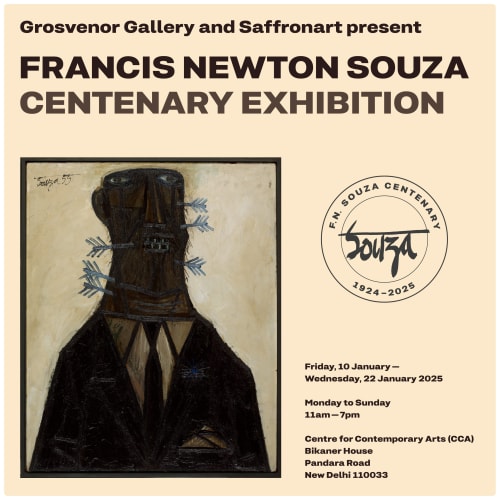Francis Newton Souza was born in the Portuguese colony of Goa to Indian parents. Along with a group of like-minded contemporaries, Souza established the Progressive Artist's Group, having their first exhibition at the Bombay Art Society in 1949. The works on show were evidence of the group's desire to break with the current political and creative rhetoric of the time. Instead of duly painting in the restrictive and conservative European style promoted by India's academic art institutions under the Raj, the PAG looked to their own Indian culture for inspiration, not viewing such arts as Hindu sculpture or Mogul painting as indigenous craft but high art form. Souza wanted his brightly coloured hip swaying temple dancers to capture the modernity of the day not the bland watercolour landscape paintings the establishment seemed to prefer.
Having only enjoyed a nominal amount success in India, Souza moved to Britain in search of a more receptive climate for his kind of art. At first, Souza struggled to make an impact in London. In order to develop his work, Souza immersed himself in the rich artistic scene of 1950s London soaking up the dialogue between himself and fellow artists, and the visual stimuli of the city's museums and galleries. The unrestrained and graphic nature of his works by the time of his show at London's Gallery One in 1955, clearly ignited the imagination the public. The show was a sell-out, and Souza started to enjoy the international acclaim he deserved.
In 1967 Souza moved to New York where he continued to paint until his death in 2002. His works are in such eminent collections as the Tate Gallery, London and the National Gallery of Modern Art, New Delhi.
One can see the influence of numerous art schools on his art, from the folk art of Goa to the powerful paintings of the Renaissance. However, as John Berger stated, 'he straddles several traditions but serves none' (John Berger, New Statesmen, February 25th, 1955). Although often acutely distorted, Souza's landscapes and figures never dissolve entirely into complete abstraction. Likewise, while his subject matters can be dark and melancholy his works still often retain a large amount of humour and irony. Souza's works are ultimately about the significance of life painted with 'a visual intensity intended to jolt the nervous system like an electric shock into a visceral awareness of life'.
We are thankful to all the private lenders including KNMA for their loans and support.

